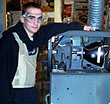|
|
 
|
|
Author
|
Topic: How to do an analog A-chain alignment
|
|
|
Manny Knowles
"What are these things and WHY are they BLUE???"

Posts: 4247
From: Bloomington, IN, USA
Registered: Feb 2002
|
 posted 09-17-2003 05:58 PM
posted 09-17-2003 05:58 PM




Caution: The A-chain is a critical alignment.
First things first -- what's your level of experience in this area? Your topic header "How to do..." suggests that you've never done an A-Chain Alignment but your question "What's the best way..." suggests that maybe you're just looking for tips to improve upon your technique. Which is it?
If you are a complete novice, then I would personally recommend that you get some hands-on instruction with an experienced tech to guide you until you can do this alone.
The whole process made perfect sense when I read about it in the Dolby manuals and elsewhere...but actually doing it turned out to be a whole different ballgame. I was overwhelmed by all the test film, the equipment, the sheer number of steps involved and the hand-eye coordination needed. I did not achieve good results until an experienced technician showed me how to do it. Two or three practice sessions was all it took -- less than an hour in all -- but the personal assistance, the advice and the feedback (as I worked) was invaluable. And I have to say I've gotten better at it over time -- can do it faster and get a better alignment -- all with practice.
So my point is this: The A-Chain Alignment is a "doing" thing, not a "reading" thing, in my opinion. You could easily make your theatres sound worse despite the fact that you will probably get some EXCELLENT instruction and tips here on the site.
You will need to have an oscilloscope, RTA and some test films. Do you have those already?
A classic example of something you can't get out of the manuals -- You need to be able to connect your o'scope and your RTA at the same time. So in addition to the scope and the analyzer, you're also going to need extra cables and a signal splitter. I don't know about USL processors but all of my Dolby's made it necessary for me to get little pin adapters for my BNC cables. By the time my visit with the tech was done I had a complete shopping list of absolutely everything I would need.
In the meantime -- while you wait for further postings here -- you might take a look at www.smartdev.com and click on "Technical Tips" and then follow the "Theatre Sound Installation" link. They have a description of the A-chain procedure there that was easy to understand when I was starting although, as I said, none of the written stuff really helped me at first.
Good luck to you.
| IP: Logged
|
|
Jack Ondracek
Film God

Posts: 2348
From: Port Orchard, WA, USA
Registered: Oct 2002
|
 posted 09-17-2003 06:22 PM
posted 09-17-2003 06:22 PM





Not wanting to set off a firestorm here (though I may be sticking my big size 10 in my face), I'd think you shouldn't have to do A-chains very often at all... especially since you're using a reverse scan pickup. Once an A-chain alignment is done properly, you shouldn't have to do much other than check your dolby levels now and then.
I recently checked up on a CP55 that had been installed about 5 years ago. The reverse scanner was conservatively set, since we had plenty of gain in the preamp (read: LED not being hammered). When I looped the soundhead, I found that the levels were almost exactly where they should be.
Here's where the debate probably lies, because I wouldn't doubt there are those who feel the need to make this a part of their weekly routine. Personally, I don't know why you'd need to check A-chain more than once a year at most, unless you notice something out of whack when you do your auditorium checks...
If you have meddlers in your booth, all of this goes out the window. If not, get it done right then leave it alone. Worry about alignment issues if you change or repair things in your soundheads or amplifiers, or if you need to work on your speakers or auditorium treatments. Loop your soundhead often enough to satisfy yourself the Dolby's ok. That isn't complicated, and will give you an idea what kind of "drift" your system will exhibit over time.
As for how to do a full alignment, there should be information about that in the manual for your processor. I'd agree with Manny... if you've never actually seen it done, go find somebody to watch for a while. It's not totally a "by the numbers" technique, and you need to understand the judgment calls you need to adjust for when actually listening to your work in the auditorium. Tackling this cold is probably not a good idea.
| IP: Logged
|
|
|
|
|
|
|
|
|
|
|
|
|
|
|
|
|
|
All times are Central (GMT -6:00)
|
|
Powered by Infopop Corporation
UBB.classicTM
6.3.1.2
The Film-Tech Forums are designed for various members related to the cinema industry to express their opinions, viewpoints and testimonials on various products, services and events based upon speculation, personal knowledge and factual information through use, therefore all views represented here allow no liability upon the publishers of this web site and the owners of said views assume no liability for any ill will resulting from these postings. The posts made here are for educational as well as entertainment purposes and as such anyone viewing this portion of the website must accept these views as statements of the author of that opinion
and agrees to release the authors from any and all liability.
|

 Home
Home
 Products
Products
 Store
Store
 Forum
Forum
 Warehouse
Warehouse
 Contact Us
Contact Us




 Printer-friendly view of this topic
Printer-friendly view of this topic









![[Smile]](smile.gif)






